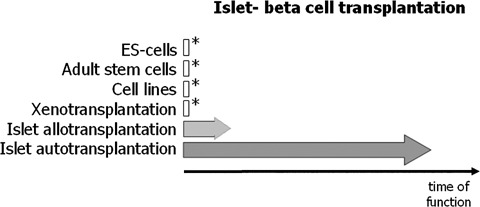1.

Schematic representation of the progress/success in islet or β-cell transplantation. Asterisks symbolize the experimental state of the approach. The approach using embryonal stem cells still awaits ethical decisions. Similar to the approach aiming at the establishment of cell lines capable to substitute islet β-cells also embryonal stem cells bear the danger of oncologic transformations due to the many necessary in vitro population doublings. Another possibility is the use of xeno-islets, such as procine islets, for transplantation. Although having the advantage of being a sustainable islet source, many obstacles such as the antigenicity (due to the β-galactosyl antigen which is present in most non-human primates) and infection with zoonoses (such as the pig endogenous retroviruses) still remain [23]. The biological proof of principle showing a long-lasting and stable insulin production of islets transplanted into the liver has already been shown in autotransplantations [29]. Although the current immunosuppressive therapies have improved the outcome of islet allotransplantations, most patients once they reach 5 years post-transplantation do not sustain insulin independence [24].
